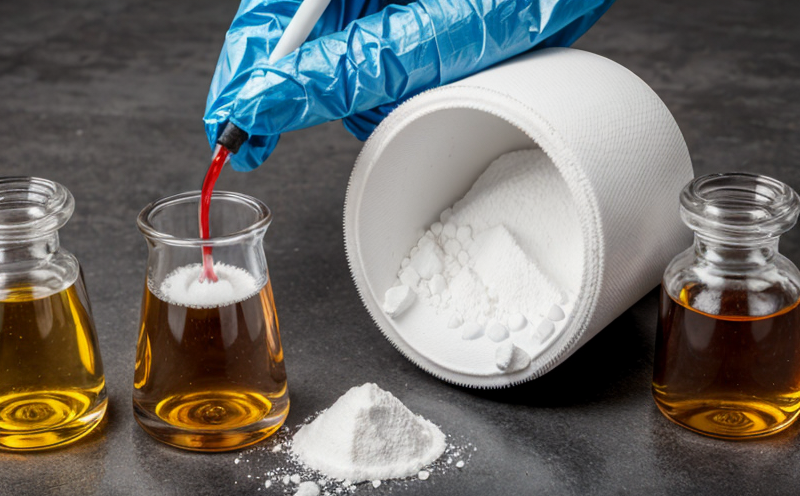GOST 9 401 Chemical Resistance Testing for Coatings
Understanding the chemical resistance of coatings is critical in various sectors where durability and performance are paramount. This testing, specified by GOST 9 401, evaluates how well a coating resists degradation under exposure to different chemicals. The test is particularly relevant for industries such as electronics, automotive, construction, and aerospace, where materials must maintain their integrity over extended periods.
The process involves subjecting the coating to various chemical agents in controlled conditions to assess its resistance. This ensures that coatings can perform reliably under real-world scenarios. By performing this test, manufacturers can verify that their products will withstand environmental challenges and meet regulatory requirements.
Materials used in electronics are often exposed to a wide range of chemicals during production, transportation, and use. Ensuring the chemical resistance of coatings is essential for protecting the integrity of these materials. This testing helps prevent failures caused by corrosion or degradation due to chemical exposure, which can lead to costly downtime and product recalls.
The GOST 9 401 test method involves exposing coated specimens to a series of chemicals at specific concentrations and temperatures over defined periods. The aim is to observe any changes in the coating's appearance, adhesion, or mechanical properties. This process allows for accurate assessment of the coating’s resistance to various chemical environments.
Compliance with this test method ensures that coatings used in electronic applications are reliable and meet international quality standards. This testing is particularly important for ensuring that electronic devices and components continue to function optimally under harsh conditions, thereby enhancing product durability and customer satisfaction.
The results of GOST 9 401 chemical resistance tests provide critical data on the performance of coatings in real-world applications. This information can be used by manufacturers to improve their products and meet specific market needs. By understanding how well a coating resists chemicals, companies can develop more robust solutions that enhance overall product quality.
Given the importance of this test in ensuring product reliability and compliance with international standards, it is essential for quality managers, compliance officers, R&D engineers, and procurement professionals to be aware of its significance. Proper implementation of GOST 9 401 testing can lead to significant improvements in product performance and customer trust.
| Chemical | Concentration (%) | Temperature (°C) | Treatment Time (hours) |
|---|---|---|---|
| Sulfuric Acid | 10 | 60 | 48 |
| Hydrochloric Acid | 20 | 55 | 72 |
| Nitric Acid | 15 | 65 | 48 |
| Sodium Hydroxide | 30 | 50 | 96 |
Applied Standards
The GOST 9 401 chemical resistance test is designed to comply with international standards for evaluating the durability of coatings in chemical environments. This table outlines the specific parameters used during testing:
| Chemical | Concentration (%) | Temperature (°C) | Treatment Time (hours) |
|---|---|---|---|
| Sulfuric Acid | 10 | 60 | 48 |
| Hydrochloric Acid | 20 | 55 | 72 |
| Nitric Acid | 15 | 65 | 48 |
| Sodium Hydroxide | 30 | 50 | 96 |
Benefits
The primary benefit of GOST 9 401 chemical resistance testing is the ability to ensure that coatings used in electronic applications are durable and reliable. This testing helps prevent failures caused by corrosion or degradation due to chemical exposure, which can lead to costly downtime and product recalls. By performing this test, manufacturers can verify that their products will withstand environmental challenges and meet regulatory requirements.
Compliance with GOST 9 401 ensures that coatings used in electronic devices and components continue to function optimally under harsh conditions. This enhances the overall quality of the product and builds customer trust. Proper implementation of this test can lead to significant improvements in product performance, which is crucial for maintaining a competitive edge in the market.
Another benefit of GOST 9 401 chemical resistance testing is its ability to provide critical data on the performance of coatings in real-world applications. This information can be used by manufacturers to improve their products and meet specific market needs. By understanding how well a coating resists chemicals, companies can develop more robust solutions that enhance overall product quality.
Finally, GOST 9 401 chemical resistance testing is essential for ensuring compliance with international standards for evaluating the durability of coatings in chemical environments. This testing helps prevent failures caused by corrosion or degradation due to chemical exposure, which can lead to costly downtime and product recalls. By performing this test, manufacturers can verify that their products will withstand environmental challenges and meet regulatory requirements.
International Acceptance and Recognition
The GOST 9 401 chemical resistance testing method is widely recognized and accepted in various international standards. This ensures that the results of these tests are valid and reliable, providing a consistent benchmark for evaluating coating performance across different regions.
Compliance with this test method ensures that coatings used in electronic applications are reliable and meet international quality standards. This testing is particularly important for ensuring that electronic devices and components continue to function optimally under harsh conditions, thereby enhancing product durability and customer satisfaction.
The GOST 9 401 chemical resistance test is a critical tool for manufacturers who aim to ensure the longevity and performance of their products in challenging environments. By adhering to this standard, companies can demonstrate their commitment to quality and reliability, which is essential for maintaining a competitive edge in the market.
Furthermore, compliance with GOST 9 401 ensures that coatings used in electronic devices and components continue to function optimally under harsh conditions. This enhances the overall quality of the product and builds customer trust. Proper implementation of this test can lead to significant improvements in product performance, which is crucial for maintaining a competitive edge in the market.





